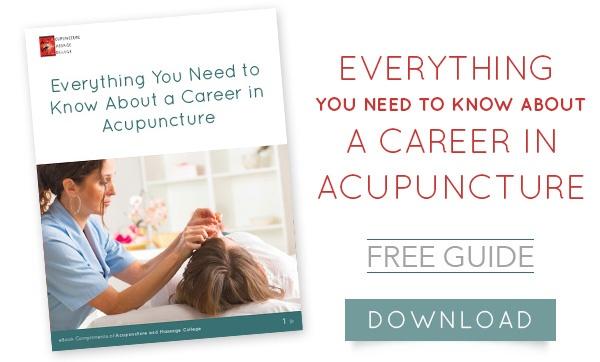Disclaimer: The information provided on this site is intended for your general knowledge only and is not a substitute for professional medical advice or treatment for specific medical conditions. You should not use this information to diagnose or treat a health problem or disease without consulting with a qualified healthcare provider. Please consult your healthcare provider with any questions or concerns you may have regarding your condition.
In our Philosophy and Traditional Chinese Medicine (TCM) blog series, we discussed the differences between holistic and conventional medicine and explained why Traditional Chinese Medicine, also known as Oriental Medicine, is considered to be holistic medicine.
More recently, we have been discussing the differences between alternative and complementary approaches to holistic medicine. Holistic medicine is considered to be alternative medicine when it acts in place of a typical conventional medical practice. However, when a holistic practice is used in conjunction with a conventional practice, it is considered to be complementary medicine. In the previous article, we discussed the complementary approach to holistic medicine in great detail.
In this article, we will discuss particular instances where the healing modalities of TCM, especially acupuncture, have been shown to be effective complementary practices.
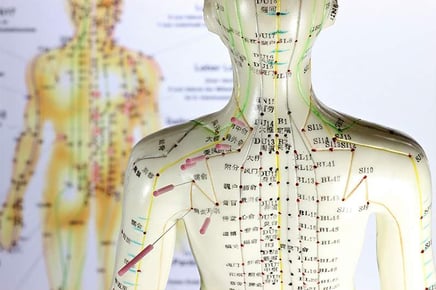
However, before we dive into specific case studies, it is worth mentioning that the practice of using Oriental Medicine as a complementary treatment to is not a new idea.
American meets Acupuncture: While visiting China in 1971, James Reston, a 62-year old reporter for the New York Times, underwent emergency surgery for a ruptured appendix. Following his surgery, he received a pain treatment that would forever change how Americans viewed science and medicine. He wrote:
“Li Chang-yuan, doctor of acupuncture at the hospital, with my approval, inserted three long, thin needles into the outer part of my right elbow and below my knees and manipulated them in order to stimulate the intestine and relieve the pressure and distension of the stomach….had the effect of diverting my attention from the distress in my stomach. Meanwhile, Doctor Li lit two pieces of an herb called ai, which looked like the burning stumps of a broken cheap cigar, and held them close to my abdomen while occasionally twirling the needles into action.”
The description of Reston’s pain treatment in The New York Times is believed to be largely how Traditional Chinese Medicine entered the American mainstream.
Interestingly enough, Reston’s description of acupuncture occurs after conventional surgery. This shows that even as early as the 1970’s, acupuncture was being used not as a standalone procedure, but as a complementary treatment.
Rather than crediting Reston with introducing TCM to the American public, perhaps it is more accurate to credit him with introducing Traditional Chinese Medicine as a complementary practice.
.png?width=425&name=TBT11%20(1).png)
James Reston receiving acupuncture
Since the 1970’s, extensive research has been done on the effectiveness of Oriental Medicine as a complementary practice. In the last article, I detailed the criteria that a holistic practice should have if it is to be considered a useful, complementary medical practice. Now, let’s explore some instances where Traditional Chinese Medicine can be utilized as an effective, complementary medicine.
Parkinson ’s Disease: Parkinson’s disease (PD) is a long-term neurodegenerative disease that affects up to 1 million people in the US. It primarily affects the motor system of the central nervous system and some its symptoms include shaking, the stiffness of the limbs, and difficulty walking. As the disease progresses, neurological problems, such as dementia, arise. Unfortunately, there is no cure for Parkinson’s disease yet, but there are ways to deal with the symptoms.
Conventional medicine has two main approaches to treating the symptoms of Parkinson’s. The first is through a special kind of surgery called Deep Brain Stimulation (DBS), which is effective at suppressing the tremor symptoms of Parkinson’s disease. The second is through medication. Anti-PD medication, such as levodopa and MAO-B inhibitors are prescribed to manage motor system problems, such limb rigidity.
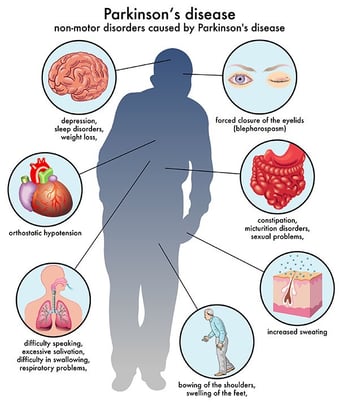
Parkinson's symptoms.
Surgery and medication are good at treating many of the major neurological issues that contribute to PD. However, these treatments can also produce unwanted side effects. For example, side effects of levodopa, particularly in high doses, can include hypotension and insomnia. Similarly, side-effects of DBS may include depression and balance problems, not mention that the procedure itself can be costly and many patients only choose to undergo it after regular medication losses its effectiveness.
Those struggling with PD or from the side-effects its
In one major analysis of acupuncture treatments on PD, 19 out of 25 experiments indicated that acupuncture plus conventional treatment was better for treating the symptoms of PD versus conventional treatment alone, especially when it came to improving the life-quality of the patients, such as “increasing sleep quality.”
The same study goes on to state that acupuncture was shown to “alleviate the symptoms of PD, delay the progression of the symptoms, allow for a decrease in the dosage of antiparkinsonian drugs, and decrease side effects.” This and other studies show that there is good evidence to support that acupuncture is an effective complementary treatment to conventional PD medication.
Pain Management and Opioid Reduction-In 2012, perhaps the most stringent and detailed study done on acupuncture found that it was effective in treating four kinds of chronic pain: back and neck pain, osteoarthritis, chronic headache, and shoulder pain.
The study analyzed 18,000 patients from 29 randomized controlled studies. In it, they found that acupuncture reduced the pain across the four chronic pain categories in 50% of patients, but that only 42% of patients in a placebo group experienced pain reduction. Meanwhile, only 30% of patients treated with fake acupuncture experienced pain reduction.
This study showed that there was a statistical difference in pain reduction between acupuncture, no acupuncture, and fake acupuncture. The statistical comparison between real and fake acupuncture is particularly significant because it reveals that the placebo effect does not explain the healing effects of (real) acupuncture.
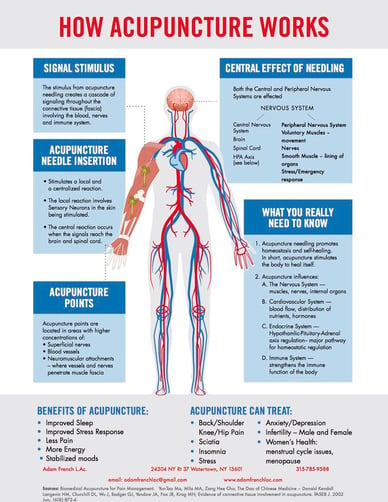
While this study analyzes acupuncture as a standalone treatment, the confirmation of its effectiveness for treating pain is particularly important for evaluating acupuncture’s role as a complementary practice.
For example, one area where acupuncture is often utilized as a complementary practice for pain relief is in managing postoperative pain. Following surgery, it is common for patients to experience postoperative pain. Typically, the pain is treated with prescription opioids, such as oxycodone and morphine, which act as pain blockers.
However, opioids are known to have serious potential side effects, such as respiratory depression, heavy sedation, and vomiting. Furthermore, opioids are highly-addictive and abuse of prescription pain-killers has unfortunately become so common, that in 2016 alone, a record 64,000 Americans died from opioid overdoses. According to the American Society of Addiction Medicine, “four in five new heroin users started out misusing prescription painkillers.”
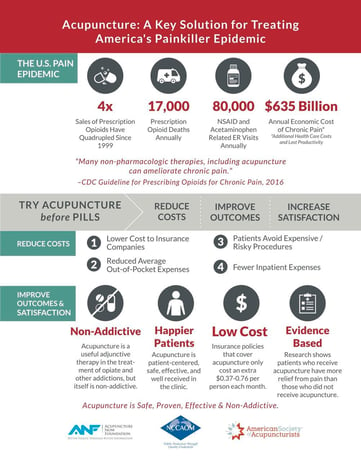 Why you should try acupuncture before opioids.
Why you should try acupuncture before opioids.
Luckily, acupuncture (and electroacupuncture) shows promise as a complementary treatment for postoperative pain, as an effective painkiller and as a means to reduce pain medication dosing requirements.
In one major study, postoperative patients treated with acupuncture “had less pain and used less opioid analgesics on the first day after surgery compared with those treated with a control.”
Furthermore, another study indicated that postoperative patients treated with acupuncture and opioids had a “lower incidence of opioid-related side-effects, such as nausea, dizziness, sedation, pruritus, and urinary retention.”
As such, there is strong evidence to support that acupuncture is an effective complementary treatment to postoperative painkillers, because it treats pain, reduces opioid use, and helps manage opioid side effects.
Depression and Anxiety: In a previous blog, we mentioned that many people with depression seek alternatives treatments to prescription antidepressant medication. One of the main reasons for this is that antidepressants can have potentially negative side effects. One of the most commonly prescribed classes of drugs for anxiety and depression are Selective Serotonin Reuptake Inhibitors (SSRIs). SSRIs treat depression and anxiety by increasing the level of serotonin in the brain, which then improves a person’s mood. However, SSRIs can have several negative side-effects, including weight gain, heart palpitations, and insomnia.
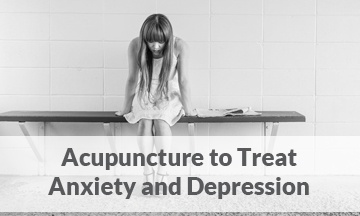
As such, many have turned to Traditional Chinese Medicine (TCM) to find an alternative treatment for depression. As discussed previously, there are many studies that support that acupuncture is an effective, alternative treatment for depression.
Despite being a good alternative to antidepressants, it is interesting to note that acupuncture is also a good complementary practice to SSRIs. According to one systematic review, when acupuncture is used in conjunction with SSRIs, the “treatment combination appears to result in greater therapeutic efficacy than SSRI therapy alone.”
This example demonstrates that holistic treatments do not necessarily have to be used as an alternative to conventional medicine, even when there is evidence that they are effective on their own.
The Future of Holistic Practices: Interestingly enough, this is the first time we have discussed a holistic practice that can be used as an alternative treatment and complementary treatment for the same illness.
Is combing conventional and non-conventional treatments the current trend for holistic practices? Maybe. According to the NCCIH, “True alternative medicine is uncommon. Most people who use non-mainstream approaches use them along with conventional treatments.”
What does the complementary approach suggest about the future of TCM in the modern West? Does this mean that Traditional Chinese Medicine will cease to be used as an alternative practice? Can Oriental Medicine be influenced by modernity, technology, and other approaches to science and medicine, while still remaining effective?
In the next article, we will discuss the modern innovations in Traditional Chinese Medicine and its future as a medical practice.
If this article interested you, learn more about a career in acupuncture by downloading our free career guide below. Acupuncture and Massage College is located in Miami, FL and offers an accredited degree program in Oriental Medicine.
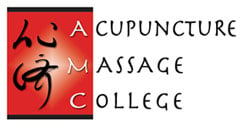
 (305) 595-9500
(305) 595-9500



